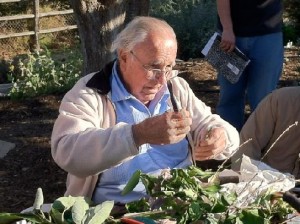Bruce Van Dyke
Bruce Van Dyke, Horticulturist

Bruce Van Dyke
Teaching grafting technique
Spring 2012
Bruce Van Dyke taught Horticulture at the nascent Santa Barbara Junior College for about five years before switching over in 1953 to the Adult Ed program under Sam Wake’s direction. The Horticulture program at the Junior College, separately funded through Federal grants, specifically benefited veterans. At Adult Ed the course became a Gardening and/ or Plant Maintenance offering .
Bruce attended Westwood before it became UCLA, starting as a Physics major. His education on hold for a stint in the Armed Forces, he returned to finish, with a switch to Horticulture. At about that time the rapidly evolving University system moved the Westwood Horticulture Department to Riverside, where, in 1907, the California State Legislature had established the citrus Experiment Station (to research agricultural issues in Southern California).
The Horticulture professors, however, with their nice homes in LA, stayed to re-invent themselves in the Botany program at what would become UCLA. Bruce notes that all the gas stations in Westwood at the time featured tall, quaint towers, before 1960’s trends streamlined them into angular aerospace simplicity.
California landscapists were just recognizing (as had agriculturists for some time) the suitability of sub-tropicals to the west coast with its Mediterranean-like climate and soil, emphasizing the various orchard crops: citruses and avocados, as well as bird of paradise, mulberry, camelia, many other plants of Asian origin, and ‘exotic’ grasses (pampas). This coincided with what was already a vital industry in California.
Bruce came to Santa Barbara in 1948, built his own business grafting fruit trees and other varieties, and eventually built his own home here while also teaching.
Bruce Van Dyke’s classes were all ‘hands-on’, and his classroom spaces varied. There had been a grammar school down Santa Barbara Street (now the Anacapa School site), and there was a former kindergarten classroom on the first block of de la Guerra; for a while his class was situated at the former Goleta Union School (closed 1976) / rec building on Hollister (now the Goleta Community Center). Bruce taught Gardening and Plant management through the Adult Ed program for 43 years. His popular classes enjoyed an enthusiastic following.
In the 1960’s Hanna Puacz, aka Ganna Walska, enlisted Bruce Van Dyke to obtain and situate plants in appropriate settings at her Lotus Land estate. Bruce, only one among a cadre of artisans, landscapers, and other horticulturists, recalls ‘rough’ methods in expressing and achieving her aspirations. He also gave tours of the developing, and uniquely exotic gardens.
Bruce was serving on the Parks Commission in 1976 when Prop 13 was implemented which, among others, discontinued the gardener at the “Mission” rose garden across from Mission Santa Barbara. When the garden began deteriorating almost immediately, it occurred to Bruce to just tend it himself, and with a friend began pruning it. Fortunately a citizen-interest committee formed in the early ‘80’s to develop a program to save the garden from becoming a parking lot. Now named the A.C. Postel Rose Garden, endowed from the Virginia Firth Wade Endowment Fund, an annual stipend of $5,000 provides basic maintenance. There is a part-time gardener but the garden continues to require volunteers to keep it in beauty and health.
Still active with the Santa Barbara Orchid Society, Bruce served as Manager of the Santa Barbara International Orchid Show for two decades (1974 – 1995); the show is held annually at Earl Warren Show Grounds.
“The Curious Horticulturist” Bruce Van Dyke was recognized for his numerous contributions to our community since arriving in 1948 with The Heritage Oak Award for Lifetime Achievement, presented by David Gress, Past President, Santa Barbara Beautiful. Van Dyke’s contributions over the years have been diverse. He has been and is an educator, mentor, writer, orchid aficionado, and dedicated volunteer in the service of community beautification.” Casa Magazine, October 12, 2007